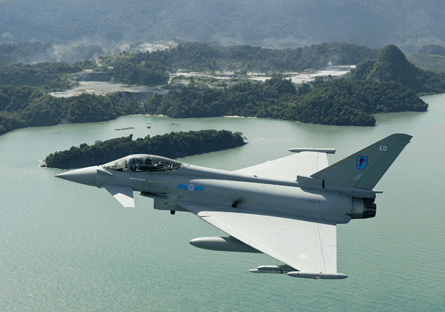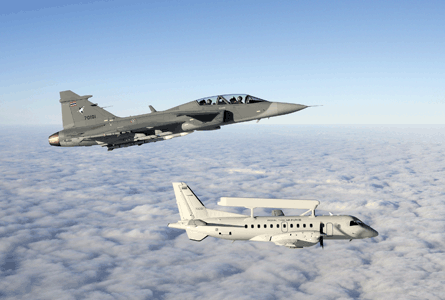Malaysia has a commanding position astride two of the world's most strategic waterways, the Straits of Malacca and the South China Sea. The importance of these sea lines of communication to major powers such as China, Japan and South Korea cannot be overstated. Through these waters flows the lifeblood of their economies. From the west flows oil from the Middle East and from the east flows finished goods bound for Europe.
Although Malaysia and its neighbours have been at peace for decades, it is worth remembering that in 1941 Japan mounted a major campaign on the peninsula with the objective of securing Singapore and establishing a springboard to the Dutch East Indies, now Indonesia. Although a major conflict in the region seems unlikely today, in any such contingency Malaysia will be a factor in the minds of strategic planners.
 |
|---|
© Geoff Lee/Eurofighter Malaysia's defence minister has said the Typhoon is best for the nation |
The country also faces a unique challenge in that it is divided between two distinct land masses, peninsular Malaysia and the island of Borneo, with the large, resource-rich states of Sabah and Sarawak. Malaysia also has a claim to the Spratly Islands, which are subject to competing claims by Indonesia, Brunei, the Philippines and China. Indeed, China claims the greater part of the South China Sea and is adding the military capabilities to back it up. This is arguably the single most vexing foreign policy issue facing southeast Asia's leaders.
In this context, the Royal Malaysian Air Force faces key decisions about the future of its combat fleet. The main combat strength of the RMAF is a hodgepodge of five types from the USA, the UK and Russia, that offer little or no commonality. It operates eight McDonnell Douglas F/A-18D Hornets, 10 Northrop F/RF-5Es, 14 BAE Systems Hawk 208s, 10 Mikoyan MiG-29s, and 18 Sukhoi Su-30MKMs. The future composition of this force will be the salient element of the Langkawi International Maritime and Aerospace Exhibition (LIMA) 2011 to be held in mid-December.
"The biggest strategic challenges facing the RMAF is how it can project airpower over the territorial waters of Malaysia, particularly into the South China Sea," said Richard Bitzinger, senior fellow at the Military Transformations programme at Singapore's Rajaratnam School of International Studies. "This is where the Malaysians perhaps face their greatest potential threats [from China]. On the operational side, the RMAF seriously needs to build a 'holistic' force, including AEW aircraft, AAR, and centralised command and control."
The RMAF's most advanced type is the Su-30MKM, obtained under a 2003 deal. Its other fighters face serious sustainment issues. The F-5s are increasingly expensive to operate and while the RMAF is apparently satisfied with its F-18s, these 1980s-era aircraft are also increasingly expensive to maintain and operate - not to mention being increasingly dated against the threats Malaysia is likely to face.
The highest priority for the RMAF, however, is the replacement of its MiG-29s. These ageing aircraft have reportedly suffered a number of maintenance issues since their acquisition in the 1990s, with several industry sources claiming the fleet is often grounded. The replacement will be addressed by a long-running 18 aircraft requirement that is unfulfilled - and likely to remain so until after Malaysia's next election, expected in 2012 or 2013.
Contenders for the requirement include the Boeing F/A-18 E/F, Eurofighter Typhoon, and Saab Gripen. The Dassault Rafale may also mount a challenge. An industry source confirmed the French company opened a sales office for the Rafale in Kuala Lumpur earlier this year.
As for the timing of a decision, one industry source calls this the "$64 million question". A request for information was issued in April 2010, and a request for proposals in February this year. Given that Malaysia hopes to field the fighters by 2015-2016, a decision could be announced at LIMA in 2013. As for the aircraft itself, Malaysia is calling for a multi-role aircraft for the aerial supremacy, ground attack, and maritime attack roles.
The F/A-18 E/F, Typhoon, and Gripen will all be present at this year's show. The Gripens will come from the Thai Air Force, which has ordered 12 of the Swedish type. Two UK Royal Air Force Typhoons will be stationed at Butterworth air base to perform a flying display. A full-sized Eurofighter mock-up will be at the show, as will a Eurofighter simulator.
Bitzinger suggests Boeing still has the best shot at winning. "The RMAF already operates older F-18s. Also, the Malaysians may wish to reach out to the USA strategically, to complement its recent purchase of Russian fighters. If not the Super Hornet, the Gripen might make a wiser choice as it is cheaper to buy and operate but, then again, countries don't always buy military equipment for their military rationales."
Despite industry consensus there will be no decision until after the next election, Boeing hopes the winner will be announced soon. "By the time LIMA occurs, the RMAF will have done a thorough evaluation of the major competitors," says the airframer. "The RMAF and the minister of defence should be in a position to make a recommendation to the prime minister for the MRCA [multi-role combat aircraft] programme."
Boeing offers a number of reasons for a Super Hornet buy. "The RMAF can expect significantly improved tactical relevancy for their Hornets when operated alongside Super Hornet aircraft. There are cost and efficiency benefits associated with embedded Super Hornet training, support and operations."
Boeing points out that Malaysia has bought and paid for US-built weapons, which can be easily integrated with the Super Hornet platform. The RMAF is familiar with the type's capabilities owing to the near constant presence of US aircraft carrier battle groups in the region. A source in Malaysia says US Navy pilots flying Super Hornets often conduct dissimilar training against RMAF Sukhoi Su-30s.
Malaysia's ties to the UK, which is leading the Eurofighter campaign in Malaysia, also run deep. In early November, the Royal Air Force sent four Eurofighters to Singapore to participate in a Five Powers Defence Arrangements exercise between the UK, Australia, New Zealand, Malaysia and Singapore. Two of these aircraft remained in Malaysia for the month leading up to LIMA.
 |
|---|
© Peter liander/Saab Thai Gripens will visit Lima |
Of the competitors, the Eurofighter is perhaps the best aircraft for the air-to-air combat role, as this was the primary driver behind its design. The company's campaign director for Malaysia, Ian Malin, says the aircraft has yet to be cleared for a maritime attack weapon since this is not an RAF requirement, but given the timeframes involved in the competition this should not be an issue.
Earlier this year, Eurofighter appeared to receive a boost when Malaysian defence minister Ahmad Zahid Hamidi was quoted as saying the Eurofighter was the best aircraft for the country. Some industry sources, however, have said his comments may have been politically motivated and not based on an objective assessment of the aircraft.
Perhaps more important than the merits of the aircraft will be the industrial participation rivals are willing to offer. After strong growth in the 1980s and early 1990s, Malaysia has struggled to move up the value chain from manufacturing to true technological innovation and production. Its government is acutely aware the country risks getting stuck in a "middle-income trap", and will look to leverage the MiG-29 replacement programme for maximum industrial benefit at home.
"Boeing continues to support the ongoing growth of Malaysian industry through our partnerships with local industry such as Asian Composites Manufacturing and placement of BCA work packages with other local companies - SME Aerospace and Composites Technology Research Malaysia Aero Composites," says Boeing.
Eurofighter and Saab will also offer attractive offset packages. "Offsets are certainly a major consideration," says Bitzinger. "Who can give the best deal and help the local defence industry with technology and jobs for national industrial development? Next they will look at what buys help with strategic relationships, and here the USA probably has the inside track."
While small compared with other fighter campaigns such as those in India, South Korea and the United Arab Emirates, big defence aerospace companies are committed to slugging it out for Malaysia's 18-aircraft fighter requirement. The contenders will be going all out at this year's LIMA.
Source: Flight International























